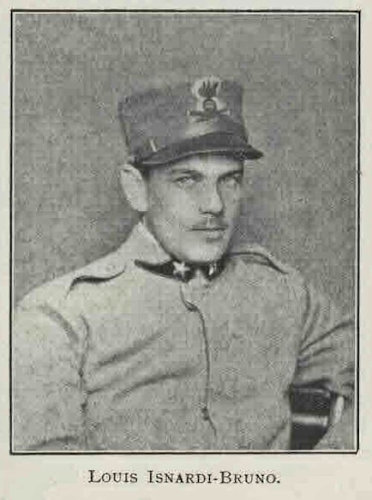Name
Louis Isnardi-Bruno
Conflict
First World War
Date of Death / Age
24/05/1917
23
Rank, Service Number & Service Details
Italian Army
26 Reggimento Artiglieria Da Campagna
Awards: Service Medals/Honour Awards
Not Yet Researched
Cemetery/Memorial: Name/Reference/Country
Not yet known
United Kingdom
Headstone Inscription
Not Researched
UK & Other Memorials
St Edmunds College Memorial, Old Hall Green,
London County & Westminster Bank, London
Biography
Louis Paul Joseph Isnardi-Bruno was born in West Ham, Essex, on 25 August 1893, the son of Bernardo Isnardi-Bruno, an Italian citizen, and his Gibraltar-born wife Elisa. He was educated at St Edmund's College, Hertfordshire. In January 1913, when he was 19 years old, he went to work for London County & Westminster Bank.
In February 1915 Isnardi-Bruno left his job as a clerk at the bank's Foreign branch in London to join the army. He seems initially to have served in the British Army, as a Gunner in the Royal Field Artillery. He later transferred to the Italian Army, serving in the 26th Regimento Artigliera di Campagna, where he was known as Luigi Isnardi-Bruno.
Soldato Isnardi-Bruno died in Gorizia on 24 May 1917 of wounds sustained in battle. He was 23 years old.
The following text was transcribed from The Edmundian (1914-1919) – The contemporary magazine of St Edmund’s College:
Luigi Isnardi-Bruno came to St. Edmund's in 1907, and in the course of five years worked his way from Third Rudiments to Poetry, a fact which may be taken as sufficient evidence of ability and hard work. His chief bent was for mathematics and modern languages, and in both of these branches he made considerable progress, speaking French, Italian and Spanish with fluency. In football and athletics he also took a high place.
Always somewhat shy and reserved he was not one " to wear his heart upon his sleeve," and consequently had few intimates, but those who knew him well recognised a character marked by sterling qualities which are often lacking in more of those of a more facile disposition. After leaving school he travelled for some time in Italy before entering the Foreign department of the London, County and Westminster Bank, where his mathematical and linguistic abilities seemed to promise a very successful career. But God willed otherwise. After the outbreak of war he was for some time undecided whether to join the English or Italian army, and though he would have readily obtained a commission in the former it was rather characteristic of him that he chose to serve as a private in the latter. He was posted to the 26th Regiment of Artillery then stationed in Piedmont. Here he did his training, and many cheery letters witnessed to the good temper and patience with which he put up with the hardships and privations (both very considerable) incidental to the life of an Italian conscript. After completing his training he was sent to the Carso, where he fell fighting with the guns he had learned to love, May 24th, 1917.
Additional Information
https://www.natwestgroupremembers.com/our-fallen/our-fallen-ww1/i/louis-isnardi-bruno.html
Acknowledgments
Jonty Wild, http://www.cadutigrandeguerra.it/CercaNome.aspx, Di Vanderson, The Edmundian (1814-1819) – The contemporary magazine of St Edmund’s College, https://www.natwestgroupremembers.com/



